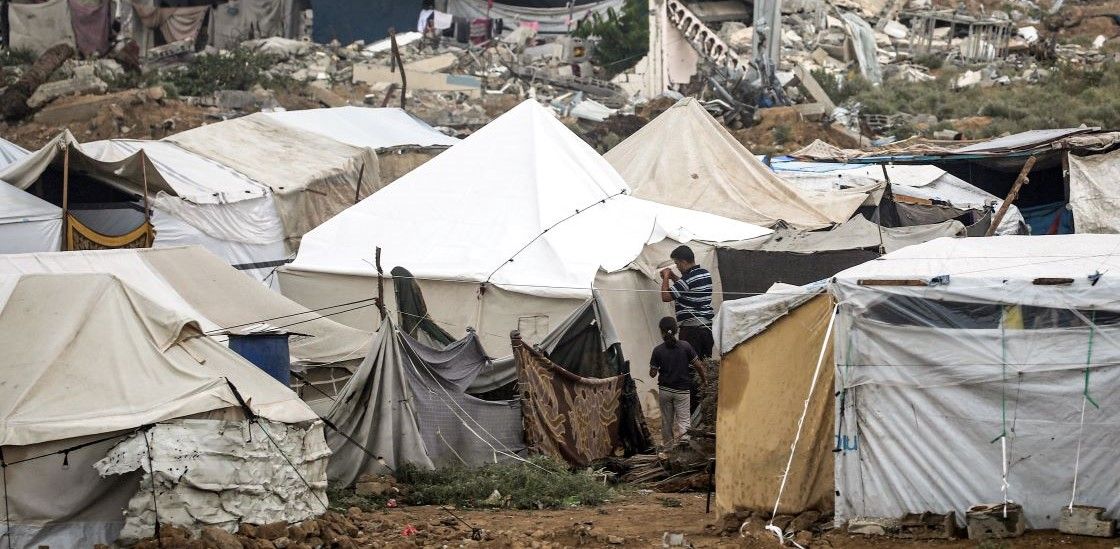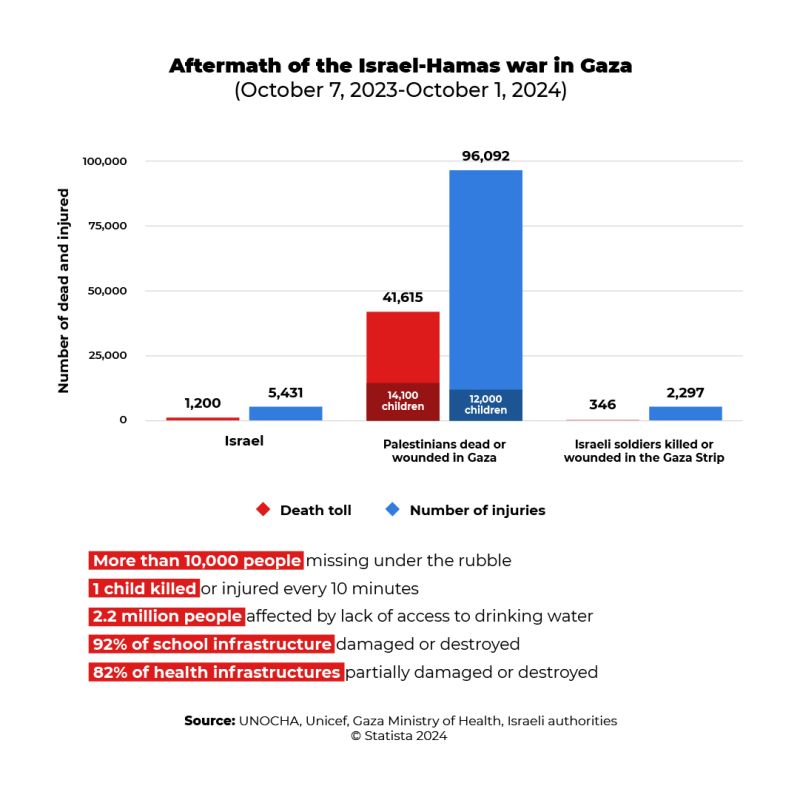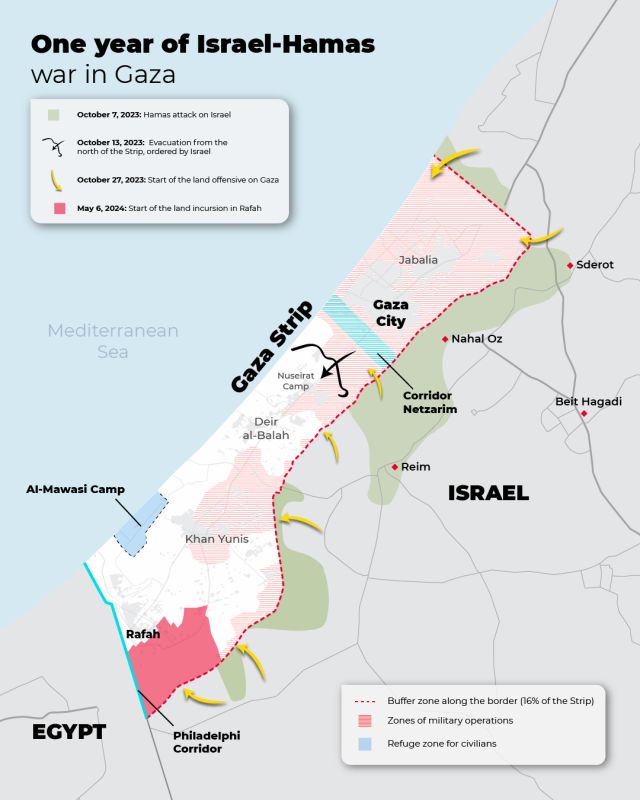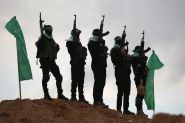- Home
- Middle East
- Gaza One Year On: A 'Relentless War of Attrition'

A man secures the ropes of one of the shelter tents erected near collapsed buildings in the Bureij camp in the central Gaza Strip on October 1, 2024 amid the ongoing war between Israel and Hamas. ©(Eyad BABA / AFP)
One year on from the unprecedented Hamas attack on Israel on October 7, 2023, the Gaza Strip has endured relentless devastation, as though the gates of hell have been unleashed. Yet, the fighting rages on, and a ceasefire remains a distant mirage. Here’s a reflection on a year of brutal conflict in the Palestinian enclave.
On October 7, 2023, Hamas' armed wing launched Operation Al-Aqsa Flood against Israel, sparking widespread panic and shock on the Israeli side. The Palestinian group carried out an unprecedented assault, firing thousands of rockets and infiltrating border areas between Gaza and Israel. It was a groundbreaking attack in the history of the Israeli-Palestinian conflict, catching Israel off guard for the first time.
The attack resulted in the deaths of nearly 1,200 Israelis, including 37 children, and left 7,500 injured. Additionally, 251 people were taken hostage by Hamas, according to Israeli authorities.
Swift Response
The very next day, the Israeli government declared a state of emergency, mobilizing its military forces for a counterattack, and conducting airstrikes targeting Hamas positions in Gaza. On October 9, Israel launched Operation “Iron Swords,” which involved targeted military sites across the Gaza Strip. Hamas retaliated by continuing its rockets attacks on Israeli cities.
This cycle of violence has been ongoing for a full year.
By October 7, 2024, Gaza—a narrow strip of land 42 kilometers long and 6 to 12 kilometers wide—was nearly leveled. Its population, around 2.1 million people, is now crammed into the Al-Mawasi region, a small area near the Egyptian border, representing roughly 3% of Gaza's territory.
One of the Bloodiest Wars of the 21st Century
The escalation of hostilities that erupted on October 7, 2023, has resulted in the deadliest conflict in the history of the Palestinian enclave, as reported by UNICEF. According to the Gaza Ministry of Health, the conflict has claimed over 41,000 lives, which accounts for around 2% of the total population, with women and children representing 60% of the casualties.
Survivors are enduring a relentless exodus, with approximately 1.9 million people continuously fleeing from the northern and central areas of the enclave, seeking refuge in the south following repeated evacuation orders issued by the Israeli military.

Living conditions in Gaza have become unbearable, with people lacking access to water, food and medicine. As the fighting continues, famine and diseases like polio pose significant challenges for the residents of the tiny enclave.
Throughout an entire year of conflict, there has been only one brief ceasefire observed by both parties, from November 24 to 30, intended for humanitarian aid deliveries. During this pause, Hamas released 24 hostages, while Israel freed 39 Palestinian prisoners.
A Three-Phased Operation
“October 7 marks the beginning of the process to eliminate Hamas,” declared Yoav Gallant, Israel’s Defense Minister, in 2023. He outlined a three-phased approach for the operation against Gaza in a statement issued by his office.
The first phase entails “a military campaign involving airstrikes and later tactical maneuvers, aimed at assassinating operatives and damaging infrastructures” to dismantle Hamas.
The second phase involves continuing combat “at a reduced intensity” to eradicate “pockets of resistance.”
The final phase would focus on “establishing a new security framework in the Gaza Strip, relieving Israel of responsibility for the situation in the area, and creating a new security reality for Israeli citizens.”
Yet, how has Israel implemented this plan throughout the past year?
The Military Campaign
In the week following the October 7 attack, the Israeli military escalated airstrikes targeting Hamas leaders and the group's infrastructure. The enclave, which had already been under an Israeli blockade since 2007—when Hamas took control of Gaza—became increasingly isolated. By mid-October 2023, the Rafah crossing was the only entry point open for humanitarian aid from Egypt. On October 27, Israeli forces entered Gaza, marking the beginning of the ground offensive.
The ensuing months brought no relief, as Israeli military operations continued targeting Hamas tunnel networks, command centers and critical military facilities. Ground operations expanded, resulting in intense fighting in the northern part of the enclave, particularly around Gaza City. Israel further escalated its military efforts, shifting its focus to central areas of Gaza.
By February 2024, over 1.5 million people—more than half the population—had sought refuge in the southern part of the enclave, specifically in Rafah, a border town with Egypt. However, for Israeli Prime Minister Benjamin Netanyahu, this area represented the last major stronghold of Hamas. “We will fight until complete victory, which requires strong action in Rafah,” he stated on February 14 via his Telegram account. Consequently, plans for a ground offensive in this refuge city began to take shape, despite increasing protests from the international community.

In April, the Israeli military engaged in operations described as “limited in scope,” according to one of its spokespersons, aimed at temporarily evacuating residents from eastern Rafah. They were urged to relocate to “humanitarian zones,” primarily the Al-Mawasi camp, located about ten kilometers from Rafah.
On May 6, 2024, the Israeli army entered Rafah, marking a significant turning point in the conflict. Israeli troops established positions in the southernmost part of the enclave, reclaiming control of the Philadelphia Corridor, a buffer zone between Egypt and Gaza. Prime Minister Netanyahu declared that the war would persist until this corridor was secured against arms smuggling that benefited Hamas.
The summer of 2024 was marked by even greater bloodshed. Eleven months into the conflict, Gallant asserted in September that “Hamas no longer exists as a military entity.” He claimed that the group had shifted to guerrilla tactics, which the Israeli state continued to actively combat.
The Decapitation of Hamas
Benjamin Netanyahu has consistently emphasized his determination to eliminate Hamas, both militarily and politically. As part of this effort, several high-ranking figures of the Palestinian group have been targeted and killed.
On January 2, Saleh al-Arouri, Hamas' second-in-command, was killed in an airstrike that hit the building housing the group’s office in the southern suburb of Beirut. This area, known as Dahyeh, serves as a stronghold for Hezbollah, another Iranian proxy. Saleh al-Arouri was a founding member of the Al-Qassam Brigades, Hamas’ military wing, and served as the vice president of the group’s political bureau. Two other officials, including Abu Amer, Arouri’s aide and head of Hamas operations in southern Lebanon, were also killed.
While Israel did not officially claim responsibility for the attack, sources within the Israeli Prime Minister’s office indicated that Netanyahu had instructed his ministers to refrain from commenting on Arouri’s assassination. However, a US defense official, speaking off the record to the Washington Post, confirmed that the Israeli military was indeed behind the strike.
Saleh al-Arouri was not only central to Hamas' leadership, but was also seen as a key player in negotiations regarding ceasefires and the return of Israeli hostages. Another significant strike occurred on July 31 when Ismail Haniyeh, the leader of Hamas, was killed along with his bodyguard in Tehran. Again, Israel remained silent on the matter while reiterating its commitment to destroying Hamas.
Haniyeh had traveled to Tehran to attend the inauguration of Iranian President Massoud Pezeshkian. According to Iranian media, Haniyeh was staying in a veterans’ residence when he was targeted during the night. He had been elected head of Hamas' political bureau in 2017 and had played a significant role within the organization since its inception in 1987. Known for his ability to balance armed resistance with political maneuvering within the group, Haniyeh maintained good relations with leaders of various Palestinian factions.
Yahya Sinwar quickly took over leadership after Haniyeh, known for his more hardline stance and alleged involvement in orchestrating the events of October 7. A veteran of Hamas, Sinwar represents the hardline wing within the group. A senior Hamas official stated off the records to AFP that Sinwar’s appointment as the new political leader of Hamas sends a “strong message” of resistance to Israel.
A Transformed Territory
In addition to military operations targeting Hamas positions and leaders, Tel Aviv has initiated large-scale infrastructure projects within Gaza that have fundamentally reshaped the Gaza territory. Construction work that began in February 2024 has led to the establishment of the Netzarim Corridor, a militarized zone stretching from east to west across the Palestinian enclave, effectively dividing the northern and southern regions of Gaza.
This corridor spans nearly two kilometers in width and features a 6.8-kilometer road that can be covered in just seven minutes. It connects southern Israel (the Nahal Oz region) to the Mediterranean Sea, effectively isolating Gaza City in the north from the rest of the enclave. This area serves multiple military and strategic interests for Israel, primarily aimed at consolidating security control over Gaza.
But at What Cost?
This transformation has come at the expense of widespread destruction, with many buildings—including hospitals, universities and entire villages—being leveled.
Furthermore, alongside this military initiative, the Israeli army has broadened the area designated as restricted for Palestinians along the Gaza border, establishing a buffer zone exceeding one kilometer in width. Once fully implemented, this zone would account for around 16% of Gaza's overall area.
“The ongoing campaign of devastation carried out by the Israeli army in Gaza is an unwarranted act of destruction,” remarked Erika Guevara-Rosas, Amnesty International's director of research, advocacy, policy and campaigns.
A report released on September 5 noted, “Using bulldozers and manually placed explosives, the Israeli army has unlawfully destroyed agricultural land and civilian structures, razing entire neighborhoods, including residences, schools, and mosques.”
What Future Awaits Gaza?
For several months, efforts to negotiate a ceasefire in Gaza and the return of hostages held by Hamas were ongoing, under mediation from the United States, Egypt and Qatar. Nonetheless, no agreement has been reached so far, as both parties accuse each other of sabotaging the talks.
At present, the process remains stalled primarily over the Philadelphia Corridor, which Israel is determined to control—a critical issue for Egypt. As of October 3, 2024, approximately 101 individuals are still being held hostage, including two children.
On September 18, Yoav Gallant announced that the “center of gravity” in the war against Hamas is shifting northward, towards the Lebanese border, thus focusing on Hezbollah. Nevertheless, the conflict in Gaza is far from over, as new fronts are emerging with Hamas.
Nearly a year after the onset of hostilities that devastated the Gaza Strip, Yahya Sinwar asserted in September 2024 that his group is “ready” to engage in “a prolonged war of attrition” against the Israeli army. This leads to the troubling question of whether the term “open-air prison,” long used to describe Gaza, will soon be replaced by an even grimmer characterization.
This overview is focused exclusively on the Gaza Strip, which is why the situation in the West Bank has not been addressed.
Read more



Comments